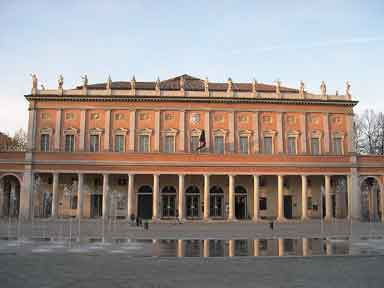Reggio Emilia is the demonstration of how often the size
of a city is not an obstacle to its cultural presence, to the wealth,
variety and professionalism of its productions. Moreover, Reggio Emilia
contributes in giving the region an image of an important stage for
theatre, music, dancing and for music instruction, where its lucky
residents can choose from an extraordinary directory for variety and
quality.
A few important beacons distinguish the Reggio music
performance beginning with three large "historical" theatres. The
Municipal Theatre, today called Romolo Valli, standing between Piazza
della Vittoria, Piazza Martiri del VII Luglio and the municipal
gardens, a most noble place whose status was recently enhanced by urban
reorganization. Of a neoclassic architecture, inaugurated in April 21,
1857, with the opera Vittor Pisani by Reggio musician Achille Peri, the
theatre is predominantly the main concert and opera house. The Foundation
I Teatri in Reggio Emilia welcomes, every three years (since 1987), the
international competition for string quartet "Premio Paolo Borciani",
promoting and organizing many of the most acclaimed string concerts of
today.
The second most important stage of the city is the Ariosto
Theatre, built in 1878 on the ashes of a previous theatre of the
eighteenth century (of which there are a few remains) intended immediately
for all sorts of theatre representations (prose, music, circus) and
restructured in the twentieth century to allow operatic representations,
even if today it is predominantly meant for prose.
The third theatre
for plays and concerts is the Teatro della Cavallerizza which, like the
other two, can be found in the large central square. Used for
equestrian activities until the end of the Second World War, it has
recently been restored in a modular structure adapted for experimental
performances and contemporary music, making it a venue for events of major
importance.
The musical panorama is enriched and completed, in Reggio
Emilia, by a very dense web of large and small music organizations, from
the historical Famiglia Artistica Reggiana (promoting concerts of very
high quality in its premises) to the very new Hirmos (promoting young
artists dedicated to music chamber in the Herberia theatre) and the choirs
in

churches (among them, the sacred organ music by the Associazione Cappella Musicale San Francesco da Paola, the Basilica della Beata Vergine della Ghiara and the Cappella Musicale di San Michele Arcangelo). The city is also, since 1979, an important centre for the art of dancing (since 2003 the Fondazione Nazionale della Danza, activities with Aterballetto) that carries out its activities at the Fonderia, an architectural recovery of the foundry of an industrial complex close to the historical centre which "from a place of fusion of heavy metal has become an efficient lab of creative fusion promoting the art of dancing that has made the Aterballetto Company a reference point of international importance".
We cannot conclude our brief overview relating to music in Reggio Emilia without mentioning the central place that the teaching of music holds in the city and in the province where excellent schools can be found (of excellent regional if not national repute), the most important one being the Istituto Superiore di Studi Musicali A. Peri. Inheriting from a school of music of the nineteenth-century, from the end of the sixties in the twentieth century under the direction of Armando Gentilucci, it has definitely looked towards the future and has positioned itself not only as an outstanding school of music in connection with all the music institutions of the city and the province, as a centre for fundamental research and production of contemporary music thanks to the presence of the magazine Musica/RealtÓ and to a library which, because of its wealth in musical heritage of the twentieth century, is the destination of scholars and researchers. Let us not forget that the school A. Peri is also a place of music production, concerts, reviews, seminars and meetings that light up not only the concert hall, but also so many other places in the city and in the province.